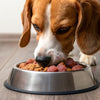Understanding How Many Calories in Raw Dog Food: A Comprehensive Guide
- Houndsy
Table of Contents
- Introduction
- Understanding Calories in Dog Food
- The Caloric Content of Raw Dog Food
- Transitioning to Raw Dog Food
- Common Myths About Raw Feeding
- Conclusion
Introduction
Have you ever wondered how many calories are in raw dog food? With the growing trend towards feeding pets a raw diet, understanding the calorie content is essential for ensuring our canine companions receive the balanced nutrition they need. Studies show that dogs on a raw food diet may see improved coat conditions, higher energy levels, and enhanced overall health—factors worth considering when determining how much to feed them. However, raw feeding can be a source of confusion for many pet parents, especially regarding how many calories their dogs need on a daily basis.
In this blog post, we will delve into the critical details of raw dog food calorie content and how to calculate your dog's calorie needs effectively. We will learn about the conversion of dog weight to caloric requirements, the various factors influencing these numbers, and some practical methods to understand and apply them for our pets. By the end, you will be equipped with the knowledge to tailor your dog’s meals to their unique needs, making the feeding experience both enjoyable and effective.
Your dog's diet is pivotal to their health and welfare, so grasping the concept of caloric intake will help maintain their ideal weight and prevent health issues. Let’s embark on this informative journey together, reflecting on how we can enhance our pet feeding routines through mindful calorie management.
Understanding Calories in Dog Food
What Are Calories?
At its core, a calorie is a unit of energy. Just like us, dogs require calories to fuel their daily activities—from basic functions like breathing to more vigorous exercises like running or playing fetch. The calorie content in dog food is generally represented as kilocalories (kcal), which are often just referred to as calories in common dog food discussions. When you read the food label, it’s crucial to note whether the calorie count is given per cup, per kilogram, or per serving.
Types of Calories:
- Calories (C) - Referring to kilocalories, this is what you generally see on dog food labels.
- Small calories (c) - A smaller unit not used in pet nutrition.
For simplicity, we will treat calories and kilocalories as equivalent terms in this discussion.
How Many Calories Does a Dog Need?
Determining how many calories your dog needs can fluctuate based on several factors, including age, breed, weight, metabolism, and activity level. On average, a rule of thumb is to estimate a dog’s caloric needs at approximately 30 calories per pound of body weight for adult maintenance. However, this is far from a one-size-fits-all approach!
To understand your dog’s specifics, we’ll look deeper into their resting energy requirements (RER) and daily energy requirements (DER):
-
Resting Energy Requirement (RER): This is the amount of energy your dog requires at rest and is calculated using the formula:
[ RER = 70 \times (body\ weight\ in\ kg)^{0.75} ] -
Daily Energy Requirement (DER): This total includes RER plus the energy needed for activity. For DER, you multiply RER by an activity factor. Here are some estimated multipliers:
- Neutered & Low Activity: 1.6
- Intact & Low Activity: 1.8
- Young Adult & Average Activity: 2.0
- High Activity: 2.5–5.0 (depending on the intensity)
Example of Caloric Calculation
Let’s say you have a 55-pound (about 25 kg) dog. Here’s how you would calculate their caloric needs:
-
Calculate RER: [ RER = 70 \times (25)^{0.75} \approx 780\ kcal ]
-
Determine Activity Level (e.g., average activity): [ DER = RER \times 1.6 ≈ 1248\ kcal ]
From this, we can summarize that a 55-pound dog would need about 1248 calories daily.
Factors Influencing Caloric Needs
Dog owners should take into account several variables that might influence their dog's daily calorie needs:
- Age: Puppies and young dogs may need more calories due to their growth needs, while senior dogs might require fewer.
- Activity Level: An active dog will need more calories than a dog who spends most of its time lounging.
- Health Conditions: Certain medical conditions could necessitate changes in caloric intake, either to promote weight loss or gain.
- Size and Breed: Small breeds often have a higher metabolic rate and may require more calories per pound than larger breeds.
- Environmental Factors: Weather can also play a role; dogs in colder climates may require more energy.
The Caloric Content of Raw Dog Food
When it comes to feeding dogs a raw diet, understanding the caloric content of various raw food options is vital. Raw dog food can vary greatly in its calorie density depending on ingredients, preparation methods, and fat content. Here are some typical calorie counts for various common protein sources when they are raw:
- Beef: About 577 kcal per 8 oz
- Chicken: Approximately 317 kcal per 8 oz
- Pork: Roughly 404 kcal per 8 oz
- Fish (like Salmon): Typically 286 kcal per 8 oz
- Lamb: About 526 kcal per 8 oz
Understanding Food Labels
Reading raw dog food labels is essential for determining calorie intake. Labels typically list calories per kilogram and per serving, but it’s important to see how that translates into your dog's specific needs. Most raw pet food companies will supply the kcal content nearby the nutritional information, enabling you to make informed decisions.
How to Calculate Daily Intake of Raw Food
To estimate how much raw food to feed your dog based on their caloric needs:
- Determine Caloric Needs: Use formulas outlined above to find your dog’s DER.
- Find Food Caloric Density: Check the raw food label to find how many calories per ounce or per serving it contains.
- Calculate Serving Size: [ Serving\ size\ (oz) = \frac{Daily\ calorie\ needs}{Calories\ per\ oz} ]
For example, if your dog needs 1248 kcal a day and the raw chicken you are feeding contains 317 kcal per 8 oz, the calculation becomes:
- Convert 8 oz to calories: 317 kcal / 8 = 39.625 kcal per oz.
- Now divide daily requirements:
[ \frac{1248}{39.625} \approx 31.5\ oz ]
This is a simple calculation, but always adjust quantities based on your dog's health and body condition accordingly.
Transitioning to Raw Dog Food
Key Considerations
Transitioning to a raw diet can offer significant health benefits for dogs, but moving too quickly can lead to digestive upset. Here are some tips for a smooth transition:
- Start Gradually: Introduce raw food slowly over a week or two, mixing it with their current diet.
- Monitor: Keep an eye on their stool quality and overall health during the transition.
- Consult a Vet: Always seek advice from a veterinarian, especially when switching diets or addressing health concerns.
Managing Caloric Intake through Raw Feeding
Managing caloric intake while feeding your dog raw doesn’t have to be complicated. Here are further recommendations:
- Portion Control: Make sure you’re measuring portions accurately. A Houndsy Kibble Dispenser can help with maintaining precise feeding amounts while staying aesthetically pleasing in your home.
- Nutritional Balance: Ensure your dog is receiving a balanced meal of proteins, fats, and vegetables as part of their raw diet.
- Regular Checkups: Regular vet visits can help track your dog’s weight and aid in managing caloric intake effectively.
Common Myths About Raw Feeding
Feeding our dogs raw food can come with its share of misconceptions. Let's debunk a few:
-
Raw is Always Healthier: While raw diets can offer benefits, they can also carry risks if not carefully managed. Always research quality sources and consult with your veterinarian.
-
Dogs Will Self-Regulate: Unlike cats, dogs do not have the same instincts to stop eating, so monitoring their caloric intake is key.
-
All Bones Are Bad: Certain bones can be dangerous, whereas others can provide adequate nutritional benefits. Always choose appropriately sized, raw bones.
Conclusion
The question of how many calories are in raw dog food is multifaceted, influenced by factors such as age, activity level, and specific dietary needs. By accurately calculating your dog's caloric requirements and understanding the caloric content in raw dog food, you can ensure that your furry friend remains healthy and happy.
As loving pet owners, it’s essential for us to stay informed and proactive about our dogs’ nutrition. A well-balanced and calorie-appropriate raw diet can greatly enhance our pets' lives, enabling them to thrive in our homes.
To discover how the Houndsy Kibble Dispenser can simplify portion control while perfectly showcasing your modern home decor, feel free to explore our product page. With the right tools and knowledge, we can make feeding time a seamless and enjoyable experience for both us and our pets!
FAQ
How do I know if my dog is getting enough calories in their diet?
Monitor your dog’s weight, coat condition, energy levels, and stool quality. If you're observing consistent weight changes or health concerns, adjusting their diet may be necessary.
How do I measure my dog's portion sizes correctly?
Using tools like a measuring cup for kibble or a digital kitchen scale can help ensure you are providing the correct portion sizes based on your dog’s calorie needs.
Can I mix dry kibble with raw dog food?
Yes, many owners choose to mix raw and dry food; however, ensure that it’s balanced and observe how your dog’s digestive system responds to the changes.
What should I do if my dog refuses to eat raw food?
Transitioning can take time; if your dog is resistant, try mixing raw food with their current kibble or warming it slightly to enhance the aroma. Always consult your vet if refusal persists.












